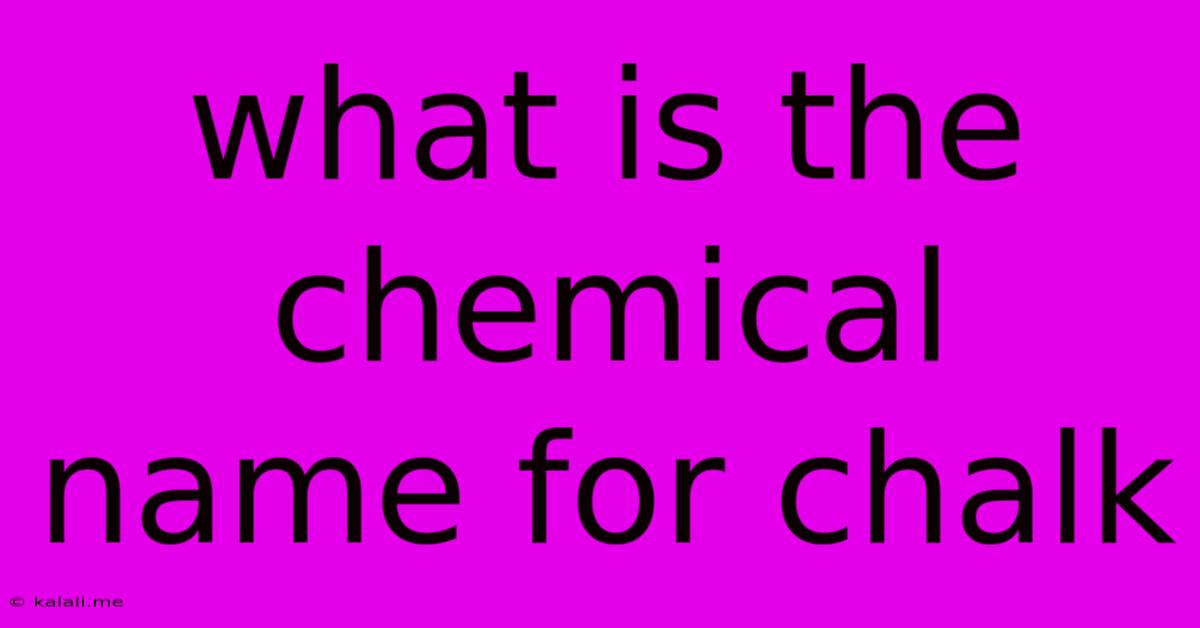What Is The Chemical Name For Chalk
Kalali
Jun 14, 2025 · 3 min read

Table of Contents
What is the Chemical Name for Chalk? Understanding Calcium Carbonate and its Forms
Chalk, that familiar white substance used on blackboards, in sidewalk art, and even in some dietary supplements, has a surprisingly simple yet fascinating chemical composition. This article will delve into the chemical name for chalk, explore its different forms, and discuss some of its common uses and properties. Learn everything you need to know about this ubiquitous material.
What is chalk, chemically speaking? The primary chemical name for chalk is calcium carbonate. This simple compound, with the chemical formula CaCO₃, is responsible for the chalk's characteristic properties. However, it's crucial to understand that "chalk" isn't always pure calcium carbonate. It's a naturally occurring sedimentary rock, meaning its composition can vary slightly depending on its origin and geological history.
Different Forms of Calcium Carbonate:
While calcium carbonate is the core component, chalk can exist in various forms, including:
- Calcite: This is the most common crystalline form of calcium carbonate found in chalk. It's characterized by its specific crystal structure and physical properties.
- Aragonite: Another crystalline form of calcium carbonate, aragonite differs from calcite in its crystal structure. While less common in chalk than calcite, it can still be present.
- Amorphous Calcium Carbonate: This form lacks a defined crystal structure, existing as a more disordered, less organized arrangement of calcium and carbonate ions.
Properties of Calcium Carbonate (Chalk):
The properties of chalk are largely determined by its chemical composition and the presence of any impurities. Key features include:
- Softness: Chalk's softness is a well-known characteristic, making it easy to write on blackboards or create artwork. This softness stems directly from the relatively weak bonds in the calcium carbonate structure.
- White Color: The white color of pure chalk comes from the light-reflecting properties of the calcium carbonate crystals. Impurities can sometimes lead to slight variations in color.
- Solubility: Calcium carbonate is only slightly soluble in water, although its solubility increases in acidic solutions. This is relevant to processes like cave formation and the weathering of chalk cliffs.
- Reactivity: Calcium carbonate reacts with acids, producing carbon dioxide gas. This reaction is often used to identify the presence of calcium carbonate.
Uses of Chalk and Calcium Carbonate:
Beyond its traditional use as a writing tool, calcium carbonate finds widespread applications in various industries:
- Agriculture: It's used as a soil amendment to improve soil structure and reduce acidity.
- Construction: It's a component of cement and other building materials.
- Dietary Supplements: Calcium carbonate is a common source of calcium in dietary supplements.
- Pharmaceuticals: It's used as a filler and antacid in some medications.
- Paper Production: It can serve as a filler and coating material in paper manufacturing.
In conclusion, while the simple answer to "What is the chemical name for chalk?" is calcium carbonate, the story extends beyond this basic formula. Understanding the different forms of calcium carbonate present in chalk, along with its key properties and numerous applications, provides a richer appreciation of this common yet versatile material. Its seemingly simple composition belies its significant role across various industries and natural processes.
Latest Posts
Latest Posts
-
Least Common Multiple Of 42 And 56
Jun 14, 2025
-
Difference Between A Sequence And Series
Jun 14, 2025
-
Elements Across A Period Have The Same Number Of
Jun 14, 2025
-
List All The Factors Of 15
Jun 14, 2025
-
Bourdon Gauges Are Commonly Used To Measure
Jun 14, 2025
Related Post
Thank you for visiting our website which covers about What Is The Chemical Name For Chalk . We hope the information provided has been useful to you. Feel free to contact us if you have any questions or need further assistance. See you next time and don't miss to bookmark.